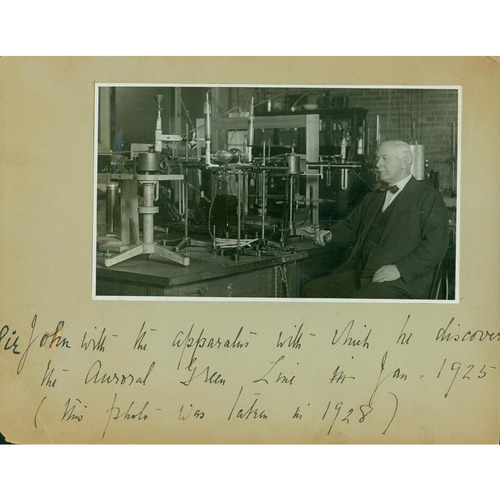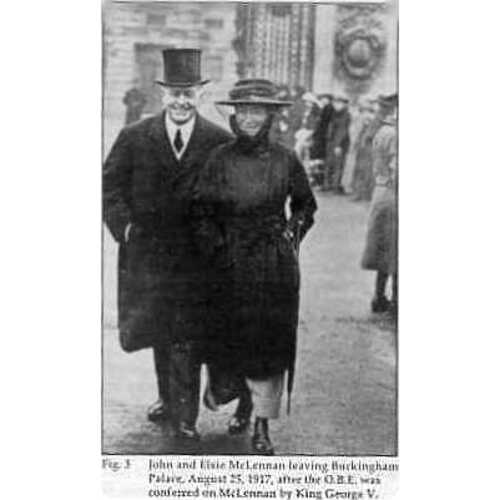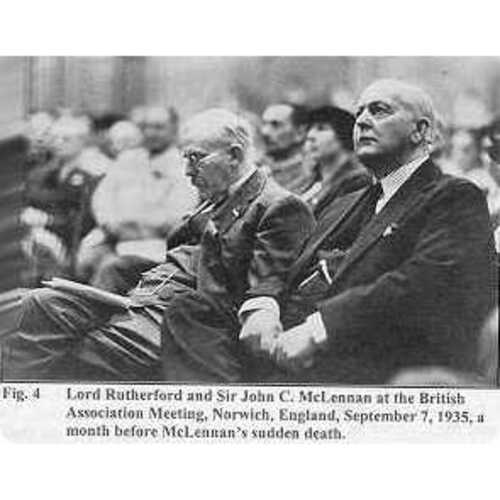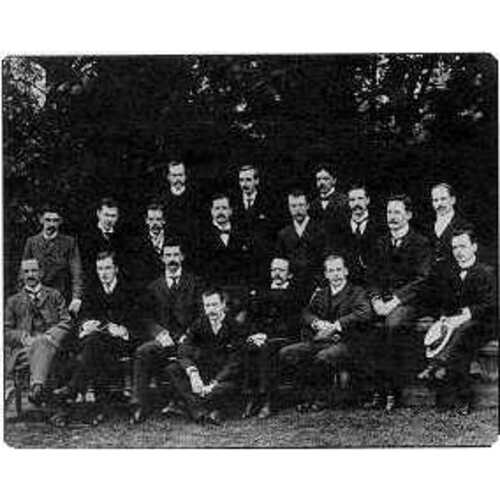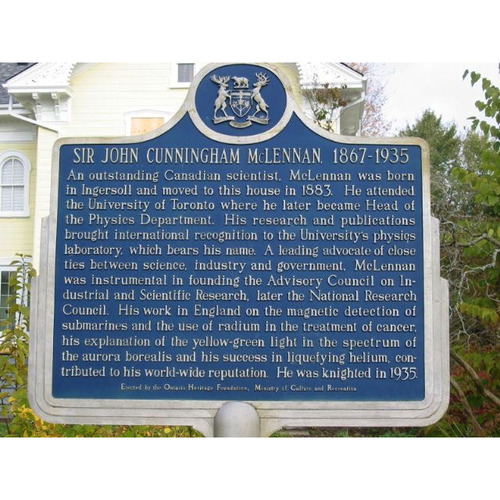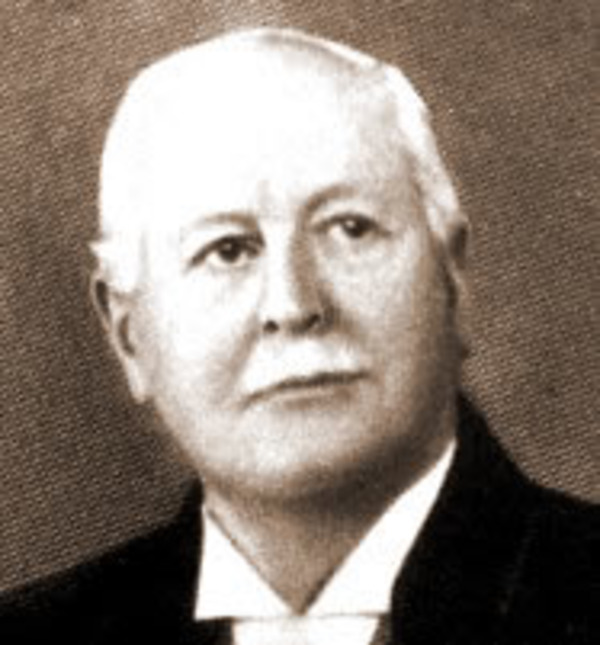
Source: Link
McLENNAN, Sir JOHN CUNNINGHAM, teacher, physicist, author, and university administrator; b. 14 April 1867 in Ingersoll, Upper Canada, son of David McLennan and Barbara Cunningham; m. 15 Sept. 1910 Elsie Monro Ramsay in Bowland, Scotland; they had no children; d. 9 Oct. 1935 near Abbeville, France.
John McLennan was the second of seven children. His father, a miller in Scotland, had emigrated to Upper Canada in 1865 and his mother arrived the next year. Following the fortunes of David McLennan’s grain business, the family moved from town to town during John’s early school years. In 1880 they located in Clinton so that John and his elder sister could attend high school. After graduating in June 1883, by which time the McLennans had moved to Stratford, John wanted to go to university but his father could not afford the expense. For the next five years he taught at various schools in Perth County, returning home on weekends to take lessons from Alexander Hiram McDougall, the mathematics master at Stratford Collegiate Institute. Finally, in 1888, he enrolled in mathematics and physics at University College in the University of Toronto. He studied under physics professor James Loudon* and graduated with first-class honours in June 1892.
Installed that summer as the university’s president, Loudon appointed McLennan assistant demonstrator of physics. He was promoted to a permanent position in 1894 and to demonstrator in 1899. With Loudon’s nephew, physics demonstrator William James Loudon, McLennan published a text in 1895, A laboratory course in experimental physics (New York and London). The same year President Loudon, who continued to head physics, encouraged him to make his first trip abroad, to meet such distinguished physicists as Oliver Joseph Lodge at University College, Liverpool, and to visit major laboratories on the continent. McLennan returned to Toronto convinced that the future of his science rested on experimental research; with Loudon’s support as president, the department of physics announced in the fall of 1896 that “special arrangements” could be made for graduate students to do “original investigations in the Laboratory.” In September 1897 McLennan told Loudon that he found it “quite impossible to carry out my laboratory work with desirable efficiency” and asked for separate space to conduct his own “special investigations” in electricity and magnetism. The physics department had its offices and undergraduate laboratories in University College, then referred to as the “Main Building”; it shared space there with other departments and the administrative offices of both the college and the university. A separate laboratory was not possible.
In 1898 an attractive opportunity arose for McLennan to pursue his research. Encouraged by Loudon, he took leave and returned to Britain to work under Joseph John Thomson at Cambridge’s Cavendish Laboratory. There he met Ernest Rutherford, who was soon to take up an appointment at McGill University in Montreal, and studied with other eminent physicists. He plunged into the recent literature on gas conductivity and began his own experimental work in October. It did not go well. There were difficulties throughout the winter of 1898–99, and in April he complained to Loudon that “for three months it was just try this and try that and always fail.” By July, however, he was done and in Berlin writing up his results; Thomson judged his experiment “a splendid success,” he reported to Loudon. His paper, “Electrical conductivity in gases traversed by cathode rays,” was published in the prestigious Proceedings of the Royal Society of London in 1900. That same year, while at the Cavendish, he was awarded the University of Toronto’s (and Canada’s) first phd in physics.
The years before World War I were a time of profound change for McLennan and Toronto’s physics department. In 1901–2 it consisted of Loudon, McLennan, fellow demonstrator W. J. Loudon, a lecturer, and two assistants. In 1902 McLennan became an associate professor. His work on radioactivity contributed, the following year, to the discovery of a penetrating radiation passing through the atmosphere (cosmic rays). In 1904 he became director of the physics laboratory and the Ontario government agreed to fund a new physics building on the Toronto campus. He and an assistant, Eli Franklin Burton*, immersed themselves in plans to establish a laboratory like the Cavendish. In 1907, a year after James Loudon’s sudden resignation, the new president, Robert Alexander Falconer*, appointed McLennan professor and head of physics. Graduate students came to work with him in his new facility, and in 1910 a Carnegie Foundation survey of major North American physics departments gave only two, Toronto and Columbia College in New York City, a clean slate. At Toronto, it reported, “the scientific results … were of superior character.”
McLennan’s status within the Canadian physics community as well as the university had already been made clear. Elected in 1903 to fellowship in the Royal Society of Canada, he was a promoter of the Canadian Institute and an advocate of stronger links between industry and scientific research. In 1906, sponsored by the federal government, he toured the country publicizing the value of the metric system to industry and foreign trade. A founder in 1900, first secretary, and a future president of the university’s Alumni Association, he assisted Loudon in raising funds for the new Convocation Hall, begun in 1904.
McLennan was not shy about his achievements. His style was blunt, he aggressively pushed his students’ advancement (and sometimes took credit for their research), and many university colleagues regarded him as “the stormy petrel of committees.” Friends such as mathematician John Charles Fields were few, and McLennan spent nearly all his waking hours with his students and his investigations in electrical conductivity and radioactivity. His interests shifted in 1911 to spectroscopy – the examination of optics and light rays – and he methodically turned his university facility into an exceptionally well-equipped spectroscopic laboratory. In 1910 his life had taken on new dimensions when he married a daughter of former Toronto businessman William Ramsay at his estate in Scotland. Elsie became McLennan’s devoted companion and an accomplished hostess who put on annual winter parties for the physics department’s students and staff and presided over tea after her husband’s Friday-afternoon seminar. Quite well-to-do, she became a prominent figure in the city; she strongly supported the Toronto Symphony Orchestra and the Women’s Auxiliary of the Canadian National Institute for the Blind.
The McLennans were in Scotland when war was declared in 1914. They returned to Toronto, bristling with patriotic fervour, just as the 1st Canadian Division left for Britain. John was too old at 47 and too unqualified to enlist – the Canadian Expeditionary Force wanted men with some military experience – but early in 1915 two of his younger colleagues did join, leaving McLennan, E. F. Burton, and John Satterly, who had joined the department in 1912, to carry on the teaching and supervision of students. Later in 1915, while in Britain, where he was elected a fellow of the Royal Society, McLennan was invited to join the Advisory Council of the government’s new Department of Scientific and Industrial Research. In December another British organization, the Royal Navy’s Board of Invention and Research, seeking a non-flammable alternative to hydrogen as the gas for airships and observation balloons, asked him to survey imperial sources of helium. He quickly found it in gas wells in southwestern Ontario and sent samples to Toronto to be analysed by Burton, Satterly, and McMaster University’s Henry Franklin Dawes. In April 1916 he found higher-quality supplies near Calgary and the next year an extraction plant was authorized to be built. By then the professor was back in England, deeply immersed in other projects, and John Patterson, an engineer, had joined the team to run the plant. Between October 1919 and April 1920, 60,000 cubic feet of helium were shipped to McLennan and the Admiralty, although by then its use had been abandoned as the airplane replaced airships for most military purposes.
Such practical work continued to mix with honours: in 1916–17 McLennan served as president of the Royal Canadian Institute. In the summer of 1917, when he was among the first to be awarded membership in the newly formed Order of the British Empire, he was working on anti-submarine devices for the Admiralty. Germany’s submarine warfare was at its height and the British were desperate to supplement aerial surveillance. McLennan, who had told the Toronto press in 1915 that the submarine’s invisibility was no match for science, had two main projects. The first was the development of a magnetic “indicator loop” which, laid on the seabed, could detect the passage of vessels and was linked to a cluster of underwater mines that could be detonated from shore. Closely related was his work on dependable magnetic and contact fuses for the notoriously unreliable contact mines. Most failed to explode when struck, and others had fuses so unstable they detonated spontaneously in all but the calmest of seas. With skilled hands in short supply, McLennan prevailed on Sir Albert Edward Kemp*, the Canadian minister of overseas military forces, to release some of his former students from the army; others were rushed overseas from his Toronto laboratory. By mid 1918 indicator loops were being deployed on Britain’s coasts and more reliable mines were being produced, though Horace Holmes, one of the students, later recalled that the problem with the unstable fuses remained.
Shortly after the armistice in November, the Admiralty decided to continue its research efforts by establishing the Department of Scientific Research and Experiment. McLennan was to be its head, as well as the director of a new central research institution within the Admiralty and its scientific adviser. He wanted the directorship badly. “It is all so big, away beyond anything I ever dreamed of, that it makes me almost tremble when I see the responsibility of it,” he wrote in December. But the project dragged on and eventually the British government refused to fund it.
His war work done, McLennan returned to Toronto and his laboratory and students. In the spring of 1919 he joined other Canadian scientists in advocating before a House of Commons committee the creation of a national research institute for Canada. He was already a member of the government’s Honorary Advisory Council for Scientific and Industrial Research, formed in 1916, and had been a vigorous spokesman for public funding, through this council, of outstanding graduate students in the pure and applied sciences. The National Research Council would not come about until 1925 [see Robert Fulford Ruttan*], but in 1917 the advisory council’s program of student support was under way. No one took more advantage of it than McLennan. Between 1918 and 1932 more than half of the students supported were in his laboratory and he got $25,000 in grants for his own projects. McLennan said that he did not want the funds “just to keep scientists busy: we want scientists to be looked upon by the public as people who can do things for them that they can’t do themselves.”
From 1918 to the early 1930s – the most productive years of McLennan’s career – he published more than 150 papers, over half of them with his graduate students. One was Gordon Merritt Shrum, who had returned from the war with the Military Medal. McLennan, focusing on cryogenics (low-temperature research), set him to work building equipment to liquefy helium, an experiment done only once before, by Dutch physicist Heike Kamerlingh Onnes. After nearly three years of trials Shrum did it, in 1923, just as he was finishing his doctoral thesis on the hydrogen spectrum. McLennan’s ultimate goal was to produce liquid helium in quantity and use it to maintain low temperatures for other experimental research. His presidency of the Royal Society of Canada in 1924–25 drew additional attention to this work. In 1925 he and Shrum, who had spent a post-doctoral year in Toronto and another with the Corning Glass Company in New York State, turned to McLennan’s earlier field, atmospheric physics. Not convinced by recent research that showed nitrogen to be the source of the green line in the aurora borealis (the northern lights), they set out to demonstrate otherwise. Shrum discovered the source was atomic oxygen, a finding later confirmed by other scientists. A major paper by McLennan and Shrum, published in Britain in 1925 in the Royal Society’s Proceedings, was the high point of McLennan’s scientific career. In 1927 he was awarded the Royal Society’s Royal Medal, and in 1928 he delivered its Bakerian Lecture on the aurora and its spectrum.
The achievements of these years yielded to unwelcome change: dashed aspiration followed by sudden loss. At first there was more recognition. In 1930 President Falconer informed McLennan that the university’s board of governors had approved his appointment as dean of the school of graduate studies. McLennan had ambitious plans. He wanted to reorganize the school’s work and improve the “social life” of graduate students, especially women. His large idea was to centralize oversight of all the university’s research efforts in a single body to be renamed the school of graduate studies and research. The other faculties and departments, however, would have none of it; they fought to preserve their entrenched autonomy and prevent control by the “stormy petrel.” Deeply disappointed, McLennan abruptly resigned his deanship and professorship, effective at the end of June 1932. His final service in Canada was his membership in 1931–32 on an Ontario royal commission on the use of radium and X‑rays in combating cancer, but its recommendation of centralized care generated controversy.
In 1932 McLennan and Elsie moved to England, where that fall they built a handsome home, Ramsay Lodge, at Virginia Water in Surrey, complete with a laboratory. They did not, however, entirely sever their relationship with Toronto: John became an emeritus professor and Elsie retained ownership of their house at 88 Prince Arthur Avenue. In England, McLennan immediately became an expert adviser to the Royal College of Physicians and the Royal College of Surgeons on the scientific basis for radium therapy. In December he and his colleagues recommended treatment by massive doses of radiation. Within months, catastrophe struck McLennan: on 20 March 1933 Elsie, perhaps his only close friend, died. Absolutely crushed, he turned into a lonely man.
In June, McLennan became chairman of the executive committee of the radium-research group and worked to acquire the radium and apparatus for a laboratory funded by the Medical Research Council and the Department of Scientific and Industrial Research. He and seven associates launched their work in 1934. Elected vice-president of the Royal Society in 1933–34, early in 1935 he received a knighthood in the Order of the British Empire, the honour he most cherished, but there was scarcely time to enjoy it. In October he went to Paris for meetings of the Bureau international des poids et mesures. After leaving by train to come home, McLennan was stricken in his compartment by a heart attack and died, alone. A funeral service was held at St Columba’s Presbyterian Church in London, and he was buried beside his wife at Stow, Scotland, not far from Bowland.
Throughout his long tenure at the University of Toronto, Sir John Cunningham McLennan had been a major contributor to physical-science research. His interests paralleled the rapidly developing fields of early-20th-century physics, from radioactivity to spectroscopy and low-temperature physics; in total he published more than 240 papers. He gained international recognition as Canada’s most prominent physicist. Upon learning of his death, Lord Rutherford, a long-time friend, wrote in the London Times that McLennan was “the acknowledged leader of science in Canada.”
But more important in the long term was his leadership of the research facility he and E. F. Burton had designed and equipped on the Toronto campus. It quickly established itself at the centre of physics in Canada and, after World War I, became a key laboratory in North America. During McLennan’s headship of the Toronto department and laboratories, there was always a sizeable contingent of graduate students there, most of them McLennan’s; 21 doctoral degrees were awarded, by far the largest number of physics doctorates awarded anywhere in Canada. Upon graduation these students began careers in teaching and research and, in the next generation, set the pattern for Canadian physics investigation. Building on McLennan’s advocacy of industrial research, one joined the National Research Council and three others went to major industrial laboratories in the United States. Among the graduates, notably, were several women, whom McLennan, against all the conventions of the time, strongly encouraged to develop careers in the discipline. One secured appointment at Mount Holyoke College in Massachusetts and another, Elizabeth Josephine Allin, who earned her degree in 1931, became a successful member of the Toronto department.
Sir John Cunningham McLennan’s publications appear in Amicus (a national electronic catalogue listing the holdings of LAC as well as of over 1,300 other libraries across Canada), Science and technology biblio. (Richardson and MacDonald), and H. H. Langton, Sir John Cunningham McLennan: a memoir; with a chapter on his scientific work by E. F. Burton (Toronto, 1939).
Stratford–Perth Arch. (Stratford, Ont.), McLennan family papers. U.K., Ministry of Defence, Admiralty Library (HM Naval Base, Portsmouth, Eng.), Report 568, Board of Invention and Research minutes. UTARMS, A1967-0007; B1965-0012; B1972-0031; B1986-0017; B1989-0017; B1992-0030. E. J. Allin, Physics at the University of Toronto, 1843–1980 (Toronto, 1981). R. C. Brown, “The life of Sir John Cunningham McLennan, ph.d., f.r.s., o.b.e., k.b.e., 1867–1935,” Physics in Canada (Toronto), 56 (2000): 91–101. Barry Countryman, Helium for airships and science: the search in Canada, 1916–1936 (Toronto, 1992). A. S. Eve, “Sir John Cunningham McLennan, 1867–1935,” Royal Soc. of London, Obit. notices of fellows, 1 (1932–35): 577–83. Yves Gingras, Physics and the rise of scientific research in Canada, trans. Peter Keating (Montreal and Kingston, Ont., 1991). John Satterly, “Sir John Cunningham McLennan, k.b.e., f.r.s.,” Physical Soc., Proc. (London), 48 (1936): 924–28. Gordon Shrum, with Peter Stursberg, Gordon Shrum: an autobiography, ed. Clive Cocking (Vancouver, 1986).
Cite This Article
Robert Craig Brown, “McLENNAN, Sir JOHN CUNNINGHAM,” in Dictionary of Canadian Biography, vol. 16, University of Toronto/Université Laval, 2003–, accessed February 19, 2025, https://www.biographi.ca/en/bio/mclennan_john_cunningham_16E.html.
The citation above shows the format for footnotes and endnotes according to the Chicago manual of style (16th edition). Information to be used in other citation formats:
| Permalink: | https://www.biographi.ca/en/bio/mclennan_john_cunningham_16E.html |
| Author of Article: | Robert Craig Brown |
| Title of Article: | McLENNAN, Sir JOHN CUNNINGHAM |
| Publication Name: | Dictionary of Canadian Biography, vol. 16 |
| Publisher: | University of Toronto/Université Laval |
| Year of revision: | 2014 |
| Access Date: | February 19, 2025 |


